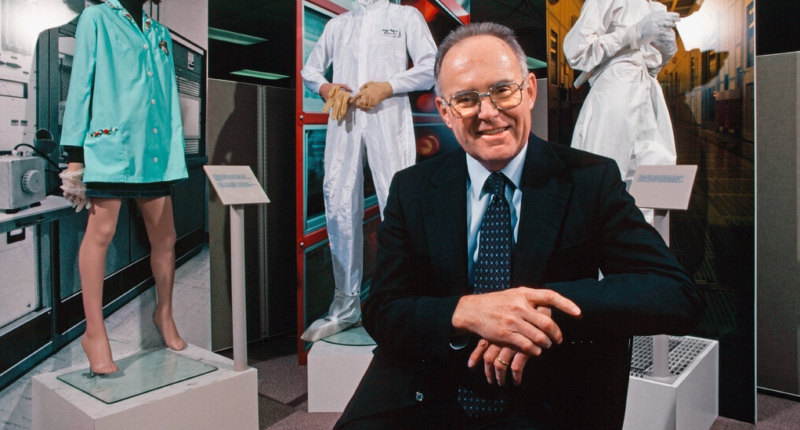Gordon Moore, the co-founder of Intel, has died at 91 years old. Moore was responsible for coining “Moore’s Law,” which stated that the number of transistors on a microchip would double every two years, leading to exponential growth in computing power. He was also instrumental in the development of the microprocessor, which helped American manufacturers to regain the lead in computer data processing from Japanese competitors. Under Moore’s watch, Intel had placed its microprocessors in 80% of the computers being made worldwide, making it the most successful semiconductor company in history. Along with his business partner, Robert Noyce, Moore started Intel in 1968 and focused on semiconductor memory. They called their start-up Integrated Electronics Corporation, which was later shortened to Intel. Despite his immense success, Moore remained unassuming throughout his life, preferring casual clothes to tailored suits. His survivors include his wife, two sons, and four grandchildren.
The Legacy of Gordon E. Moore, Intel Co-Founder
Gordon E. Moore, a co-founder of Intel Corporation, passed away at the age of 94 at his home in Hawaii. Moore was a visionary who predicted in the 1960s that computer chip technology would advance rapidly, charting a course for the age of high tech.
Moore was an accidental entrepreneur who, along with his colleagues, played a crucial role in bringing laptop computers to millions of people and embedding microprocessors into everyday items such as bathroom scales, toasters, and even toy fire engines, cellphones, cars, and jets.
It was Moore who predicted in 1965 what came to be known as Moore’s Law. He believed that the number of transistors that could be placed on a silicon chip would double at regular intervals, exponentially increasing the data-processing power of computers. Moore’s Law held up for decades, and his prediction allowed for the development of increasingly sophisticated computer technology.
Moore’s brilliance, leadership, charisma, and contacts, as well as those of his partner Robert Noyce, helped assemble a group of technicians widely regarded as among the most creative of the high-tech age. This group advocated the use of silicon chips, a highly polished, chemically treated sandy substance, for their ability to house smaller and smaller electronic circuitry that could work at higher and higher speeds.
Moore’s contribution to the industry was significant. The microchip business that he helped develop turned electronics into one of the world’s largest industries. Through his prediction, he also allowed consumers to enjoy increasingly sophisticated computer technology at increasingly affordable prices.
Moore’s passing marks the end of an era, but his legacy lives on. His work at Intel and contributions to the development of the computer chip have paved the way for the high-tech age we live in today.
Gordon E. Moore: A Pioneer of Silicon Microprocessors and Philanthropy
Gordon E. Moore, the co-founder and former chairman of Intel Corporation, has left behind a legacy that has revolutionized the computer industry. With his prediction of Moore’s Law, he became a pioneer in the development of silicon microprocessors, which would ultimately dominate the computer data-processing field.
Under Mr. Moore’s leadership, Intel regained the lead in the computer industry in the mid-1980s, thanks to its silicon microprocessors. By the ’90s, Intel had placed its microprocessors in 80% of computers being made worldwide, making it the most successful semiconductor company in history. Mr. Moore was chief executive from 1975 to 1987 and remained chairman until 1997.
Mr. Moore’s wealth grew exponentially, and he became a major figure in philanthropy. In 2001, he and his wife created the Gordon and Betty Moore Foundation with a donation of 175 million Intel shares. The foundation’s assets currently exceed $8 billion, and it has given away more than $5 billion since its founding. In 2001, they donated $600 million to the California Institute of Technology, the largest single gift to an institution of higher learning at the time.
In addition to his contributions to the computer industry and philanthropy, Mr. Moore’s character was marked by humility. He was always quick to credit others for his achievements, particularly the technical advances that Moore’s Law made possible. His prediction that semiconductor devices would make electronics more affordable proved to be precise and reliable, and technology firms based their product strategy on the assumption that Moore’s Law would hold.
Mr. Moore’s early life was marked by humble beginnings. He was born on January 3, 1929, in San Francisco, and grew up in Pescadero, a small coastal town south of San Francisco. He enrolled at San Jose State College, where he met Betty Whitaker, a journalism student, and they married in 1950. That same year, he completed his undergraduate studies at the University of California, Berkeley, with a degree in chemistry. In 1954, he received his doctorate, also in chemistry, from Caltech.
In interviews, Mr. Moore acknowledged that his prediction was not an exact science, but rather an observation based on the direction the industry was heading. He believed that semiconductor devices would make electronics more affordable, and that is the message he tried to convey. His prediction proved to be a turning point in the computer industry and made him a legend in the field.
Mr. Moore’s legacy lives on in his contributions to the computer industry and philanthropy. He was a humble and visionary leader whose work at Intel paved the way for the development of the silicon microprocessor. His prediction of Moore’s Law became the foundation of the computer industry and will be remembered as one of the greatest technological breakthroughs of our time.
Gordon E. Moore: A Pioneer in Silicon Technology
Gordon E. Moore, the co-founder of Intel Corporation, had a keen eye for innovation, which was instrumental in shaping the development of silicon technology in the computer industry. After applying for a managerial position with Dow Chemical, he was advised by a psychologist that he would never manage anything. He then joined the Applied Physics Laboratory at Johns Hopkins University and later moved to the West Coast to work with William Shockley, a co-inventor of the transistor. However, in 1957, Mr. Moore and Robert Noyce, along with six others, left to form Fairchild Semiconductor, a pioneer in manufacturing integrated circuits.
In 1968, Mr. Moore and Mr. Noyce co-founded Intel Corporation, with a focus on semiconductor memory. They received $2.5 million in capital, and their start-up was called Integrated Electronics Corporation, which was later shortened to Intel. They developed a new version of MOS technology called silicon-gate MOS, which used aluminum wires to create an integrated circuit. This technology became the foundation of Intel’s success and dominated the personal computer market.
However, Mr. Moore admitted that he missed an opportunity to manufacture a personal computer, which he partly blamed on his shortsightedness. One of Intel’s engineers suggested building a computer for the home long before Apple, but Mr. Moore couldn’t see the demand for a home computer at that time.
Despite his missed opportunity, Mr. Moore’s contributions to the computer industry were revolutionary. His foresight into semiconductor devices, his belief that silicon technology would make electronics more affordable, and his prediction of Moore’s Law proved to be game-changers in the industry. Technology firms based their product strategy on the assumption that Moore’s Law would hold, which made Mr. Moore’s prediction one of the greatest technological breakthroughs of our time.
Mr. Moore’s entrepreneurial spirit was also evident in his philanthropy work. In 2001, he and his wife created the Gordon and Betty Moore Foundation with a donation of 175 million Intel shares, and they donated $600 million to the California Institute of Technology in the same year. The foundation’s assets currently exceed $8 billion, and it has given away more than $5 billion since its founding.
Mr. Moore’s contributions to the computer industry and philanthropy made him a legend in his field. He was a humble and visionary leader who revolutionized the computer industry with his foresight into semiconductor devices and his prediction of Moore’s Law. His legacy will live on as one of the greatest technological breakthroughs of our time.
Gordon Moore was a pioneer of the semiconductor industry and co-founder of Intel Corporation, which revolutionized the computing industry. His contributions to the industry were not limited to his successful business ventures, but he is also known for his prediction in 1965, known as Moore’s Law. This law predicted that the number of transistors on a microchip would double approximately every two years, resulting in a rapid increase in processing power and a decrease in cost.
Moore began his career at Fairchild Semiconductor, where he met his future Intel co-founder Robert Noyce. After leaving Fairchild, they founded Intel in 1968 with Andrew Grove. The company initially focused on semiconductor memory, and eventually created the world’s first microprocessor. Moore’s Law became a guiding principle for the company and the entire semiconductor industry.
Moore was known for his humility and philanthropy. He and his wife established the Gordon and Betty Moore Foundation with a donation of 175 million Intel shares, which has since given away over $5 billion. Forbes estimated Moore’s net worth at $7 billion in 2014. Despite his wealth, Moore remained down-to-earth, wearing casual clothes and shopping at Costco.
Moore’s Law, however, cannot continue forever. Engineers have encountered physical limits and the cost of building factories for further miniaturization has become prohibitive. In recent years, the pace of miniaturization has slowed. Moore himself commented on the inevitable end of Moore’s Law, acknowledging that exponentials eventually reach a point of diminishing returns.
Gordon Moore passed away on January 17, 2022, at the age of 92. His legacy lives on through his contributions to the semiconductor industry and the profound impact of Moore’s Law.
Don’t miss interesting posts on Famousbio










